Word Count: 3200
16 MINUTE READ
The Chariot Festival or Car Festival or famously Ratha Yatra is a public procession carried on generally three chariots. It generally refers to the annual Ratha Yatra of Odisha, West Bengal, Jharkhand, and other East Indian states. Among all Odisha’s Ratha Yatra is the most famous, involving a public procession with chariots or rathas of deities Jagannath (Sri Krishna, Lord Vishnu’s avatar), Balabhadra (Sri Krishna’s elder brother, also known as ‘Balram’), Subhadra (Sri Krishna’s younger sister), and Sudarshana Chakra (Sri Krishna’s weapon). The chariots are generally wooden deula- shaped. This festival is not only celebrated in India but is also cherished on international platforms as well.
The word, Ratha Yatra is derived from the Sanskrit words, ‘Ratha’, meaning a chariot or carriage, and ‘Yatra’, meaning a pilgrimage or journey. ‘Yatra’ is also called ‘Jatra’ in other Indian languages like Odia.
Ratha Yatra is generally celebrated on the Shukla Paksha Dwitiya (second day of the bright fortnight) of Ashadha month. These processions have been historically common in Vishnu and Shiva-related traditions in Hinduism across India, saints and goddesses in Nepal, tribal folk traditions of eastern India, and Tirthankaras in Jainism.
The notable Ratha Yatras in India include the Ratha Yatra of Puri, Dhamrai, and Mahesh. While the Ratha Yatra associated with Jagannath, Shiva, and Mariamman, is celebrated as Ratha Yatra of Guptipara, and Santipur by Hindu communities outside India, as in Singapore.
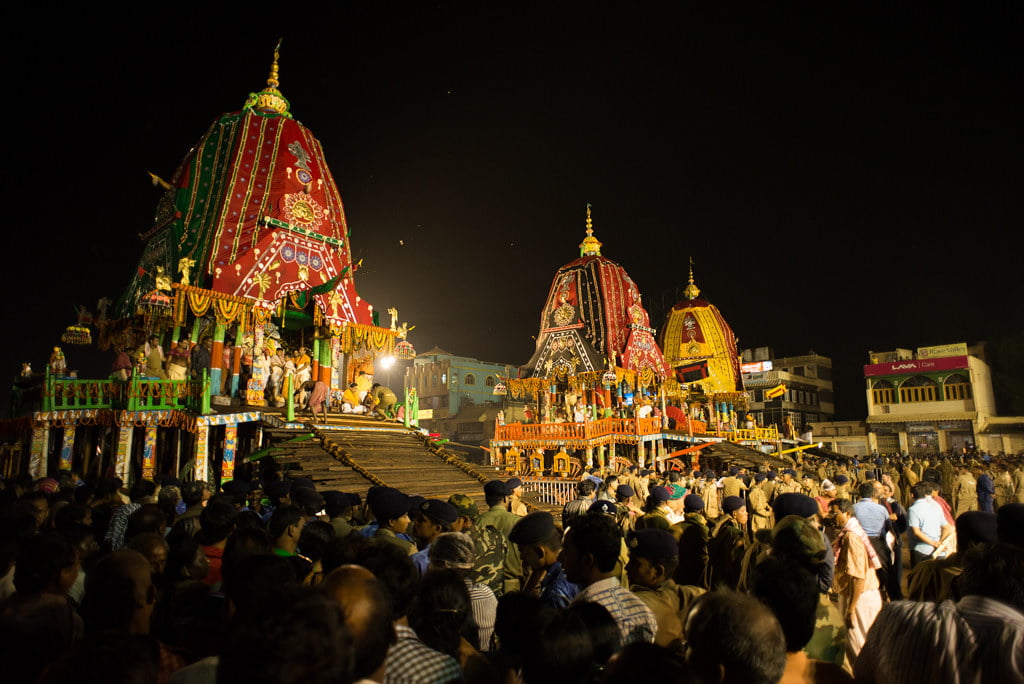
As per Knut Jacobsen, this festival has a religious origin and meaning. The events have a huge community heritage, cultural significance, and social sharing among the organizers and the participants. Talking about the western impression of the Jagannath Ratha Yatra, the westerns added a word in their dictionary, ‘Juggernaut’, on seeing the unstoppable procession of Ratha Yatra of Puri, such as the Indian culture and heritage!
The term ‘Ratha Yatra’, has appeared many times in texts of medieval India, such as in the Puranas, where there are mentions of the Ratha Yatra of Lord Surya (the Sun God), Lord Vishnu, and Devi (the Mother Goddess). The celebration of Ratha Yatra is very elaborate, where the deities come out of their temples accompanied by the public traveling with them through the Kshetra (region, streets) to another temple or the river or the sea. Many times, these festivals also include returning to the sacrosanctum of the temples.
SIGNIFICANCE
There are many stories demonstrating the significance of Rath Yatra. Some of the most popular, are as follows –
- Paying Visit to Mausi Maa –
Ratha Yatra is believed to be Lord Jagannath’s journey towards his maternal aunt’s house in the Ashadha Shukla Paksha Dwitiya. It celebrates the Lord’s visit to Gundicha Temple via Mausi Maa Temple (Maternal Aunt’s home) near Saradha Bali, Puri, where the Lord is offered Poda Pitha (a special type of pancake, which is believed to be the Lord’s favorite). After staying at Mausi’s home for seven days, Lord returns to their adobe thus completing the festival. It is also believed that, on the way to Mausi’s adobe, the chariot of the Lord waits near a crematorium of Bhakta Salabega, a Muslim devotee, who pay tribute to the Lord. This tale is the most widely accepted one by the people.
- The Legend of Gundicha Temple –
As promised to queen Gundicha, the wife of King Indradyumna, who constructed the Jagannath Temple of Puri, Lord Jagannath, Lord Balabhadra, and Goddess Subhadra pay a visit to Gundicha Temple every year. As per the theories, the present idols of Lord Jagannath, Lord Balabhadra, and Goddess Subhadra, were made from the wood log by Lord Vishwakarma in the Gundicha Temple. And Lord Vishwakarma had agreed to work on the condition that, while he would be working no one would disturb him else he would leave. It took several months and Lord Vishwakarma was still working on the idols, queen Gundicha opened the door of the temple and as per the agreement, Lord Vishwakarma disappeared leaving the idols incomplete. And since then, it is believed that Lord Jagannath, Lord Balabhadra, and Goddess Subhadra, come out of their temples once a year to visit their birthplace as they promised to the queen. After queen Gundicha, the present Gundicha temple is named, which is about 3km away from the main temple. During the time of Ratha Yatra, the deities stay at the Gundicha temple for eight days, and on the ninth day they return to their adobe, and this return journey is called the Bahuda Yatra. After the return journey, the deities enter the temple known as Niladri Bije, this brings an end to the Ratha Yatra. This story along with the story of the visit to Mausi maa is the only one mostly known by the people, the rest are less known and accepted.
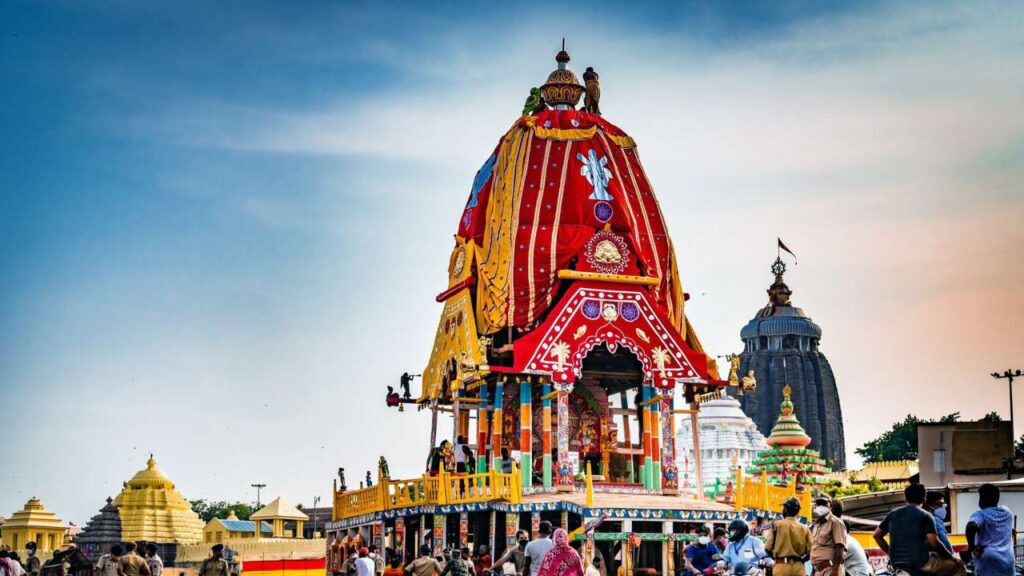
- Kansa’s Invitation –
Kansa (maternal uncle of Sri Krishna) invites Lord Krishna and Balram to Mathura, planning to kill them. So, he sent his man, Akrur with a chariot to Gokul to bring Krishna and Balram. When Lord Krishna and Balram sat on the chariot and left for Mathura, devotees celebrate this day as the beginning of Ratha Yatra. After defeating Kansa, Lord Krishna and Balram gave darshan to his devotees in Mathura, from the chariot.
- The City Tour –
The devotees of Dwarika celebrated the Ratha Yatra festival on the day when, Lord Krishna and Balram, took their sister Subhadra for a ride on a chariot to show their city’s splendor.
- The Story of Cremation –
After Lord Krishna left his mortal body, his body was cremated in Dwarika, and this deeply saddened Lord Balram, so he rushed out to drown himself in the ocean along with the partially cremated body of Sri Krishna, followed by their sister Subhadra. During the same time, King Indradyumna of Jagannath Puri dreamt that the Lord’s body would float upon the shores of Puri, the eastern shore of India. So, he should build a massive statue in his city and sanctify the wooden statues of Lord Krishna, Lord Balram, and Goddess Subhadra. He should put the asthi (bones) of Sri Krishna’s body into the hollow in the statue’s back. And his dream came true. He found the splinters of bones and took them with him. Now the problem was, who would carve the statues, so Lord Vishwakarma showed up, and he made an agreement that, while he would be working no one should disturb him, and if anyone does so, he would leave with the works unfinished. After several months, the king opened the door out of curiosity, and as per the agreement, Lord Vishwakarma disappeared. The king sanctified the idols despite they were incomplete, placed Lord’s holy cinders in the hollow of the statue, and installed them in the temple. Since then, a majestic procession is carried out every year with the idols of the deities in three humongous chariots.
SOME FACTS ABOUT RATHA YATRA
- The Ratha Yatra of Puri, Odisha, is the most visited and the largest in the world, attracting a worldwide crowd every year, with the rathas being made anew after every 12 years.
- Kendujhar Ratha Yatra is the second largest in the world. Its Ratha, Nandighosh is the tallest in the world.
- The second oldest Ratha Yatra in the world is the Baripada Ratha Yatra, it has been celebrated uninterruptedly since 1575. Baripada is also known as second Puri, or ‘Dwitiya Shrikhetra’.
- Rath Yatra of Ahmedabad, Gujarat is known to be the third-largest in the world.
- Odisha’s Sukinda Ratha Yatra is known to attract a large number of devotees.
- The most famous Ratha Yatra in Bangladesh is the Dhamrai Ratha Yatra, at Dhamrai.
- The second famous Ratha Yatra in Bangladesh is the ISCKON Dhaka Ratha Yatra.
- West Bengal’s most famous Ratha Yatra is the Rajbhalhat Ratha Yatra.
- The people of Bastar observe their Ratha Yatra during the time of Dussehra.
- The most Ratha Yatra in the U.S.A. is the Radha Rani Ratha Yatra, held at Radha Madhav Dham temple near Austin, Texas.
- Ratha Yatra is also observed in the Silicon Valley, at Golden Gate Park, San Francisco, California, USA.
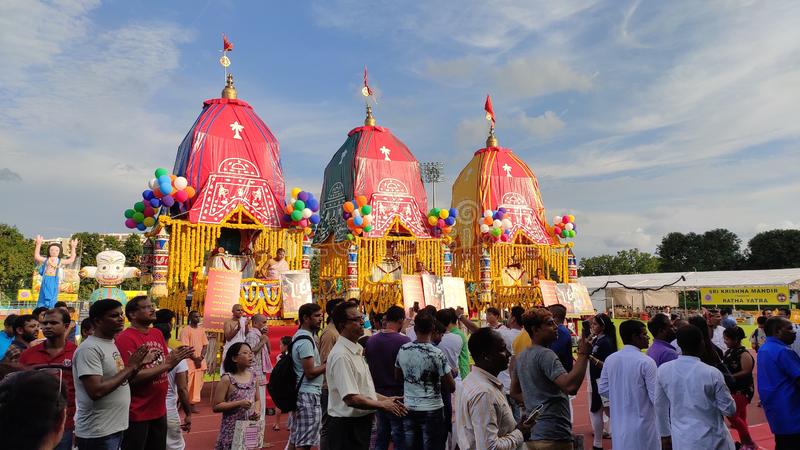
CHARIOTS AND ITS CONSTRUCTION
The chariots are an architectural marvel. All the three chariots viz. the chariots of Shri Jagannath, Balabhadra, and Subhadra, are constructed anew every year, with the use of specific woods, like dhausa, phassi, etc. The three chariots are decorated according to the unique schemes which are prescribed and is being followed for centuries. They are lined across the wide avenue in front of the Sinhadwara, or the Lion’s Gate. Around each chariot, nine Parsva devatas, wooden painted images representing different deities, are placed. Four horses and a charioteer (sarathi) accompany each chariot.
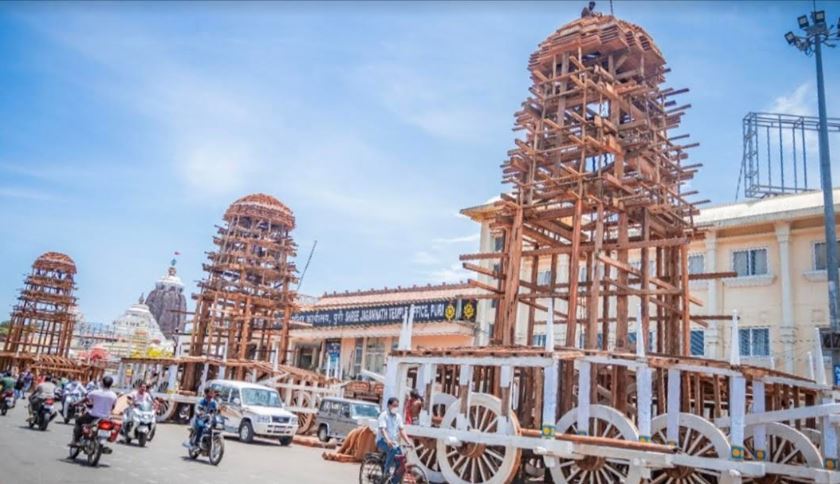
SOME FACTS –
- The Odisha State Government provides free woods for Ratha Yatra. On Vasant Panchami (or ‘Saraswati Puja’) the woods are delivered to the area outside of the Jagannath Temple Office, Puri. The state government started a plantation program in 1999 to replenish the forests, as approximately 4000 wood pieces are required to make the chariots. The logs are cut of specific sizes by Ram Navami, in April. And the chariot construction takes place in front of the royal palace near the Jagannath Temple on Akshay Tritiya (in the month of April or May). This also marks the start of a 42-day sandalwood festival, Chandan Yatra at the Jagannath Temple.
- The woods are also customarily brought from the state of Dasapalla by a special team of carpenters who have rights for the same. In Mahanadi River, these logs are traditionally set afloat as rafts, collected near Puri, and then transported via road.
- Around 200 carpenters, blacksmiths, tailors, painters, and helpers put their heart and soul, to prepare the chariots as per the strict deadline of 58-days. The craftsmen don’t require any written instructions to prepare the chariots, instead, the art is handed down from generation after generation. As per the information, it is the hereditary right of only one family of carpenters to construct the chariots.
- A holy fire ritual is performed prior to the construction of the chariots, by several priests. The construction of all the three chariots starts and ends simultaneously. The construction starts with the wheels, which resemble the large, round eyes of Sri Jagannath.
- On the last day of Chandan Yatra, the wheels are affixed to the principal axles of the chariot. For all the three chariots about 42 wheels are required to be constructed. On this day, devotees come in huge numbers to pay homage to Lord Jagannath.
- The adornment of the chariots is made with great attention and care, showcasing the beautiful craftsmanship of the Odisha’s artisans. Taking inspiration from the Odisha Temple Architecture, the wheels of the chariots are carved. The wheels and the frames of the chariots are painted in the traditional style of Odisha.
- Approx. 1250m of green, yellow, black, and red cloth with intricate embroidery is used to cover the canopies of the chariots. A special team of tailors makes the dressing of the chariots, who also make the cushions for the gods to rest.
- A day before the Ratha Yatra begins, in the afternoon, the chariots are brought to the Singahdwara, or the Lion Gate, of the Jagannath Temple. On the day of the Ratha Yatra (the first day of the festival is also known as Sri Gundicha), the deities are taken out of the Jagannath Temple and installed in the respective chariots.
- After the festival, the chariots are dismantled and the wooden logs are reused in the kitchen of the temple, which is considered one of the largest kitchens in the world. ‘Chhappan bhog’ or 56-types of mahaprasad (devotional food) to be offered to Lord Jagannath, is prepared in the kitchen using earthen pots over the fire. This kitchen can be used to cook for about 100,000 devotees per day.
- The shape of the chariots (the temple shape structure) is believed to have a special meaning, whose concept is believed to be explained in the holy text of, the Katha Upanishad. As per the concept, the chariot is representing the body, the deity inside is representing the soul, and wisdom acts as the charioteer which controls the mind and its thoughts.
- Neem wood is used to make the idols of Lord Jagannath, Lord Balabhadra, and Goddess Subhadra because according to Bhavishya Purana, neem is considered to be the most auspicious wood to make the idols of Lord Vishnu.
- Along with each deity, nine other idols are also placed in each chariot. Nine sages are also shown in each of the chariots. The Ratha of Lord Jagannath is massive about 13.7m in height. It is red and yellow in color and is called Nandighosa, and it alone takes about 2 months to construct, having 16 wheels in it. The ‘Taladwaja’, the chariot of Lord Balabhadra has 14 wheels in it, while the ‘Padmadhwaja’, the chariot of Goddess Subhadra, has 12 wheels.
- Before the commencement of Ratha Yatra, the king of Puri (also known as Gajapati), sweeps the floor of the chariot with a golden broom, depicting the king as nothing but a mere servant of God.
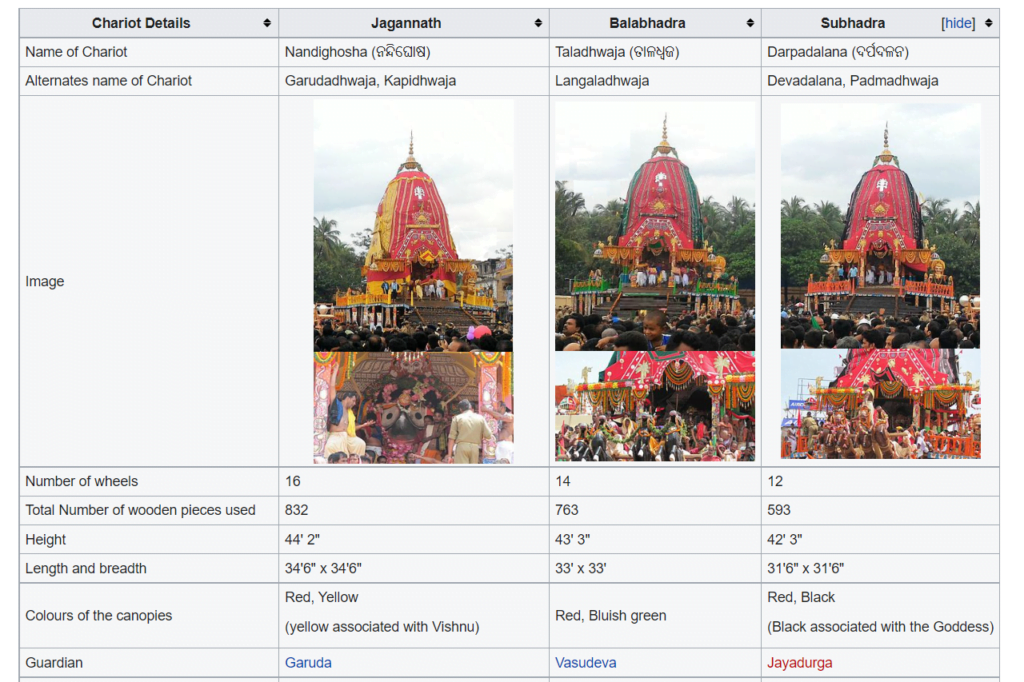
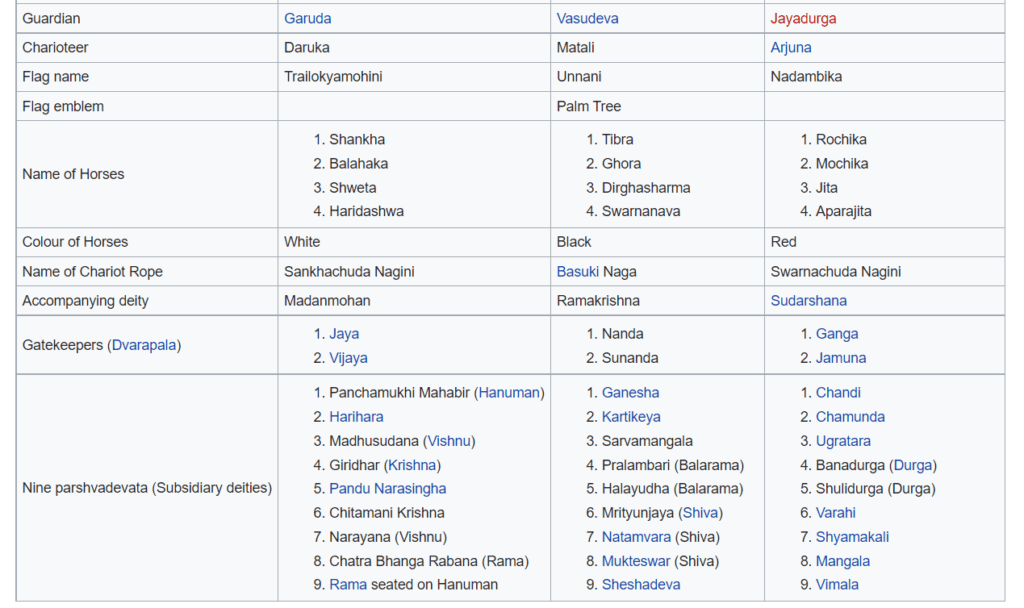
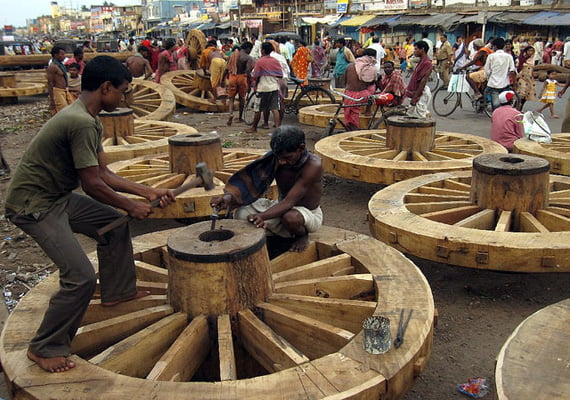
JAGANNATH PURI TEMPLE
One of the important Hindu temples dedicated to Lord Jagannath (one of the forms of Lord Vishnu, who is among the trinity of the supreme divinity in Hinduism) in the world, is the Jagannath Temple of Puri, Odisha. This temple is known for its annual Ratha Yatra. It is also among the Char Dham pilgrimage sites.
HISTORY
Avantavarman, the first emperor of the Eastern Ganga Dynasty, began the reconstruction of the temple on the site of the pre-existing temples in the compound (but not the main Jagannath Temple) in the 12th century, as suggested by the copper plate inscription, Kendupatna, of his descendant Narasimhadeva II. Inscriptions of around 1134-1135 CE show his donation to the temple, hence is supposed that the temple must have been constructed around 1112 CE.
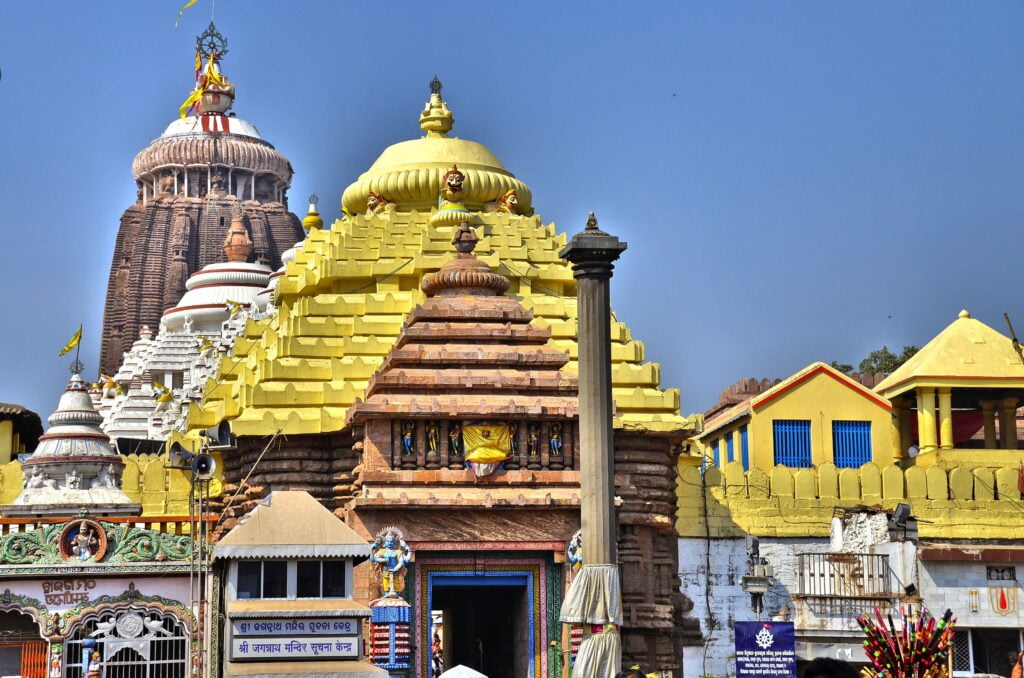
DEITIES
The trio of deities, Lord Jagannath, Lord Balabhadra, and Goddess Subhadra, are worshipped in the temple. Along with the statues of Madanmohan, Sudarshana Chakra, Vishwadhatri, and Sridevi, the statues of the trio are placed in the inner sanctum of the temple. The trio deities are carved out of the sacred neem logs known as Daru sitting on the ratnabedi or the bejeweled platform. The deities are decorated with various types of jewels and clothing, according to the season.
STRUCTURE
The Jagannath temple is spread over a huge area of over 37,000 sq.m, surrounded by a 6.1m high fortified wall, known as the Meghanada Pacheri. The main temple is surrounded by another wall called the Kurma Bedha, which contains around 120 temples and shrines. Owing to its sculptural richness and fluidity of the Oriya style of temple architecture, the Jagannath Temple is one of the most marvelous monuments in India. The four main sections of the temple are –
- The Vimana or the Garba Griha (Sanctum), where the trio deities reside in the Ratnavedi (The Thrones of Pearls), built-in Rekha Deula style.
- The frontal porch, or the Mukhashala.
- The Audience Hall or the Dancing Hall, or the Jagamohan, or Nata mandir or Natamandapa.
- The Offering Hall, or the Bhoga Mandapa.
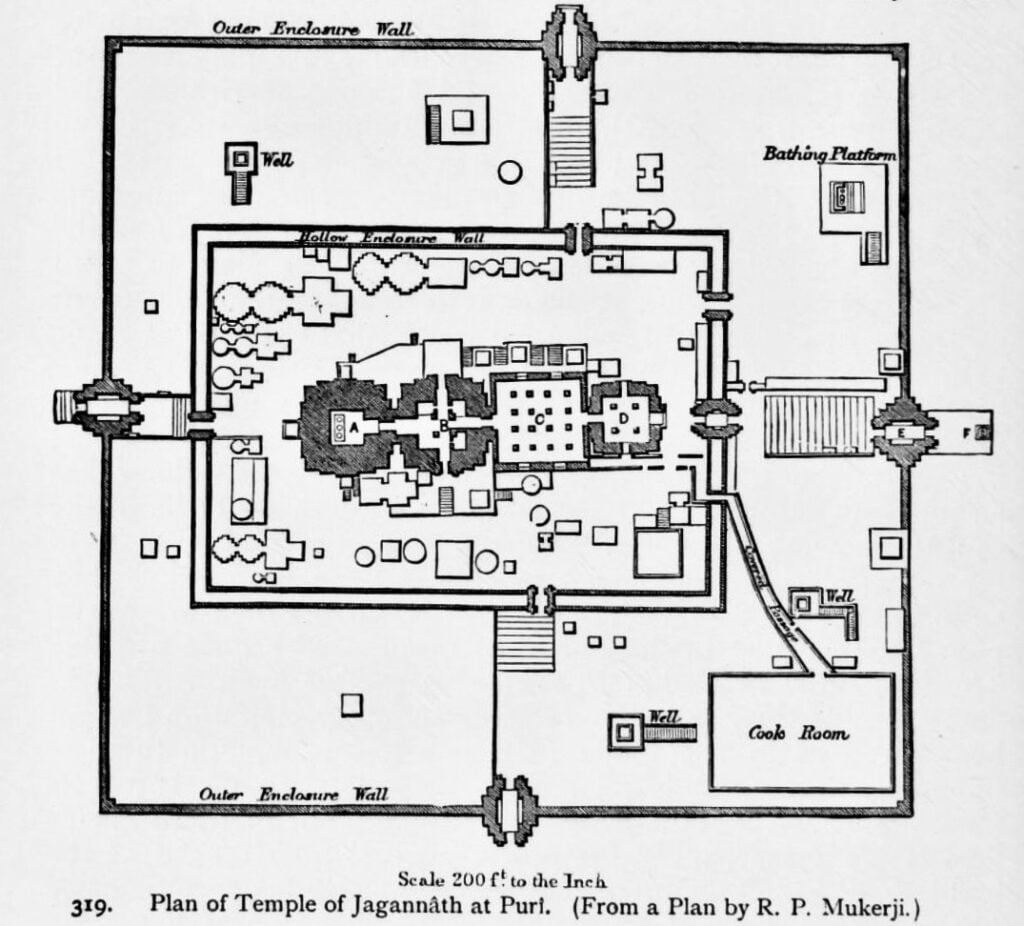
Among all other existing temples in Odisha, it is the highest. Built on a raised platform, the temple tower rises to 65m above the inner sanctum, and dominates its surrounding landscape. A ridge-like mountain peak is created by the pyramidal roofs of the surrounding temples and mandapas rising in steps towards the tower.
The main temple is in curvilinear shape, having crowning atop of the ‘Neelachakra’, or the eight-spoked wheel or the Blue Discus, of Lord Jagannath. The Neelachakra is made out of ‘Ashtadhatu’ or eight metals and is believed to be sacrosanct. According to the traditional customs, a different flag is waved in the Neelachakra every day. The flag hoisted is called the ‘Patita Pavana’ or the Purifier of the Fallen, and is similar to the deities placed in the garbagriha. On the outer circumference of the chakra, eight ‘Navagunjaras’ are carved, with all facing towards the above flagpost. The chakra is 3.5m high with a circumference of about 11m. The Archeological Survey of India repaired and restored this chakra in 2010.
Meaning ‘Lion Gate’ in Sanskrit, the Singahdwara is one of the four main gates of the temple and also forms the main entrance. It is named so because there are two statues of crouching lions on either side. It faces east opening onto the Grand Road, or the Bada Danda. Apart from this main gate, there are three more gates namely, the Hathidwara or the Elephant Gate, the Vyaghradwara or the Tiger Gate, and the Ashwadwara or the Horse Gate, facing north, south, and west, and they are named after the sculptures guarding them.
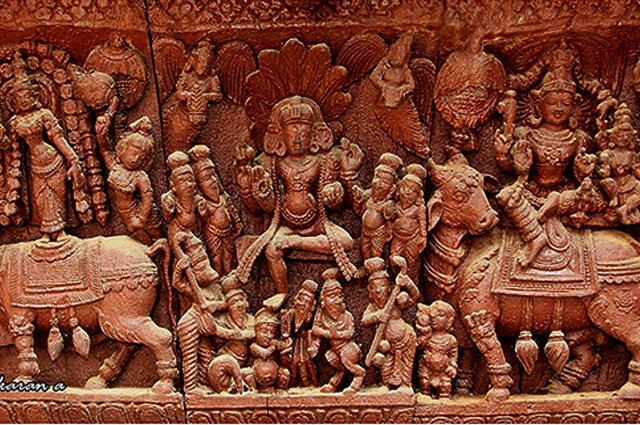
Active worship is conducted regularly in the several smaller shrines and temples, are there inside the temple complex. The Vimala Temple, located near Rohini Kund in the temple complex, is believed to be one of the most crucial of the Shaktipeeths marks, as at this spot Goddess Sati’s navel fell.
For religious congregations, several Mandapas, or Pillared halls are built on raised platforms within the temple complex, among which Mukti Mandapa is the most prominent, as selected learned Brahmins take their seat there.
SOME FACTS ABOUT JAGANNATH PURI TEMPLE
- Interestingly, no planes, not even birds, can fly over the Puri Jagannath Temple. Many theories are trying to describe this phenomenon, but it remains a mystery.
- Researchers believe that, as Odisha is in a coastal area, the extreme winds make it difficult for the birds and planes to fly at such high altitudes.
- There is also a belief that the Nilachakra blocks all wireless communications as it is made of eight different metals, thus flying aeroplanes become dangerous here.
- It is also said that the location of the temple does not come under any flying routes that’s why planes do not fly above the temple.
- According to religious beliefs, it is said that ‘Garuda Deva’, the king of birds, also the vehicle of Lord Jagannath (or Lord Vishnu), protects the Jagannath Puri temple, so the birds are scared of flying above the temple.
- Another mysterious fact about the Jagannath Temple is that the flag on the top of the sanctum of the temple always floats in the direction opposite to that of the wind, defying scientific theories.
- Another interesting fact is that the Neelachakra on the top of the temple which is about 6m high and about 2200 kg heavy and is made of about eight metals, is visible from any part of the city.
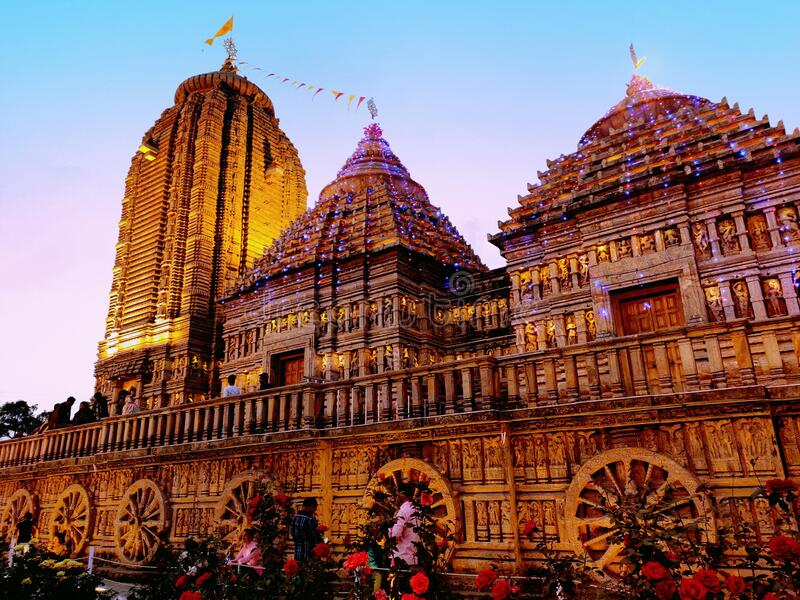
CONCLUDING WORDS!
Every year in Puri and around the world, lakhs of devotees gather to pull the magnificent chariots, as it is believed that the Lord of the Universe, Shri Jagannath, comes out of the temple for his devotees who can’t enter the temple, only once in a year. People seek this festival as a source of ‘moksha’, giving enormous importance to it. They believe that anyone, who gets a glimpse of the idols or draws or even touches the connected to the deities’ chariot will attain salvation.
Seriously, incredible is India, and so are its traditions, cultures, and heritages!!
Citations
- Wikipedia.org. (2022). Ratha Yatra (Puri). [online] Available at: https://en.wikipedia.org/wiki/Ratha_Yatra_(Puri)
- Wikipedia.org. (2022). Ratha Yatra). [online] Available at: https://en.wikipedia.org/wiki/Ratha_Yatra
- Sharma, Mahima. (2022). Jagannath Rath Yatra 2022: Day, Date and Significance. [online] Available at: https://timesofindia.indiatimes.com/religion/festivals/jagannath-rath-yatra-2022-day-date-and-significance/articleshow/92563662.cms
- Cnbctv18.com. (2022). Jagannath Rath Yatra 2022: Date, history and significance. [online] Available at: https://www.cnbctv18.com/india/jagannath-rath-yatra-2022-date-history-and-significance-13988172.htm
- Rathyatra.net. (n.d.). Origin of Rath Yatra. [online] Available at: https://www.rathyatra.net/rath-yatra-origin.html
- Indiatvnews.com. (2021). Puri Rath Yatra: Construction of chariots for Jagannath, Balabhadra and Subhadra begins. [online] Available at: https://www.indiatvnews.com/news/india/puri-rath-yatra-2021-date-chariots-construction-jagannath-balabhadra-subhadra-705102
- Firstpost.com. (n.d.). Rath Yatra 2022: Lesser-known facts about Puri Jagannath’s annual chariot festival. [online] Available at: https://www.firstpost.com/india/rath-yatra-2022-lesser-known-facts-about-puri-jagannaths-annual-chariot-festival-10858581.html
- Cook, Sharell. (2019). The Puri Rath Yatra Chariots and Why They’re Remarkable. [online] Available at: https://www.tripsavvy.com/making-of-the-puri-rath-yatra-chariots-1539264
- Wikipedia.org. (2022). Jagannath Temple, Puri. [online] Available at: https://en.wikipedia.org/wiki/Jagannath_Temple,_Puri